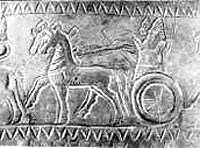Sarduri II on:
[Wikipedia]
[Google]
[Amazon]

 Sarduri II (ruled: 764–735 BC) was a
Sarduri II (ruled: 764–735 BC) was a
Chapter 8: ""Sarduri II (753-735 BC): The Golden Age of Vannic power
Urartian kings 8th-century BC rulers {{Armenia-royal-stub

King
King is the title given to a male monarch in a variety of contexts. The female equivalent is queen, which title is also given to the consort of a king.
*In the context of prehistory, antiquity and contemporary indigenous peoples, the tit ...
of Urartu
Urartu (; Assyrian: ',Eberhard Schrader, ''The Cuneiform inscriptions and the Old Testament'' (1885), p. 65. Babylonian: ''Urashtu'', he, אֲרָרָט ''Ararat'') is a geographical region and Iron Age kingdom also known as the Kingdom of Va ...
, succeeding his father Argishti I
Argishti I (), was the sixth known king of Urartu, reigning from 786 BC to 764 BC. He founded the citadel of Erebuni in 782 BC, which is the present capital of Armenia, Yerevan. Alternate transliterations of the name include ''Argishtis'', ''Argis ...
to the throne. The Urartian Kingdom was at its peak during his reign, campaigning successfully against several neighbouring powers, including Assyria
Assyria (Neo-Assyrian cuneiform: , romanized: ''māt Aššur''; syc, ܐܬܘܪ, ʾāthor) was a major ancient Mesopotamian civilization which existed as a city-state at times controlling regional territories in the indigenous lands of the A ...
.
The succession from Sarduri II is not entirely clear. There's also attested a king Sarduri III, so Rusa may also have been his son.
Sarduri II notably expanded Urartian territory by conquering the northern region of Colchis
In Greco-Roman geography, Colchis (; ) was an exonym for the Georgian polity of Egrisi ( ka, ეგრისი) located on the coast of the Black Sea, centered in present-day western Georgia (country), Georgia.
Its population, the Colchians a ...
, as well as Melid
Melid, also known as Arslantepe, was an ancient city on the Tohma River, a tributary of the upper Euphrates rising in the Taurus Mountains. It has been identified with the modern archaeological site of Arslantepe near Malatya, Turkey.
It was ...
and Kummuh
Kummuh was an Iron Age Neo-Hittite kingdom located on the west bank of the Upper Euphrates within the eastern loop of the river between Melid and Carchemish. Assyrian sources refer to both the land and its capital city by the same name. The city i ...
in the Euphrates
The Euphrates () is the longest and one of the most historically important rivers of Western Asia. Tigris–Euphrates river system, Together with the Tigris, it is one of the two defining rivers of Mesopotamia ( ''the land between the rivers'') ...
valley. In 743 BC, at a battle located somewhere in Kummuh, the Assyrians, under Tiglath-pileser III
Tiglath-Pileser III (Neo-Assyrian cuneiform: , meaning "my trust belongs to the son of Ešarra"), was the king of the Neo-Assyrian Empire from 745 BC to his death in 727. One of the most prominent and historically significant Assyrian kings, Tig ...
, defeated Sarduri and his anti-Assyrian coalition, forcing the Urartians back across the Euphrates.
Sarduri II was so confident in his power that he erected a massive wall at Tushpa (modern-day Van) with the following inscription:
:"the magnificent king, the mighty king, king of the universe, king of the land of Nairi
Nairi ( classical hy, Նայիրի, ''Nayiri'', reformed: Նաիրի, ''Nairi''; , also ''Na-'i-ru'') was the Akkadian name for a region inhabited by a particular group (possibly a confederation or league) of tribal principalities in the Armen ...
, a king having none equal to him, a shepherd to be wondered at, fearing no battle, a king who humbled those who would not submit to his authority."
He may also have been succeeded by his son, Rusa I
Rusa I (ruled: 735–714 BC) was a King of Urartu. He succeeded his father, king Sarduri II. His name is sometimes transliterated as ''Rusas'' or ''Rusha''. He was known to Assyrians as ''Ursa'' (which scholars have speculated is likely a more ac ...
. There are various theories about this, but the matter is still disputed because of the lack of solid evidence.
See also
*List of kings of Urartu
This article lists the kings of Urartu (Ararat or Kingdom of Van), an Iron Age kingdom centered on Lake Van in eastern Asia Minor.
Early kings
*Arame (also Aramu, Arama) 858 BC–844 BC
*Lutipri 844 BC–834 BC (?)
Rise to power
*Sarduri ...
References
*M. Chahin (2001) "The Kingdom of Armenia",Chapter 8: ""Sarduri II (753-735 BC): The Golden Age of Vannic power
Urartian kings 8th-century BC rulers {{Armenia-royal-stub